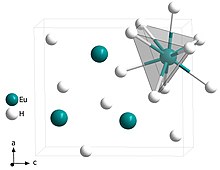
| |
| Names | |
|---|---|
| Other names
Europium(II) hydride Europium dihydride | |
| Identifiers | |
| CAS Number | |
| 3D model (JSmol) | |
| PubChem CID | |
InChI
| |
SMILES
| |
| Properties | |
| Chemical formula | EuH2 |
| Molar mass | 153.98 |
| Appearance | dark reddish powder |
| Related compounds | |
| Other anions | Europium(II) oxide Europium(II) hydroxide Europium(II) chloride |
| Other cations | samarium hydride gadolinium hydride |
| Related compounds | Europium(III) hydride |
| Except where otherwise noted, data are given for materials in their standard state (at 25 °C , 100 kPa). Infobox references | |
Europium hydride is the most common hydride of europium with a chemical formula EuH2. In this compound, europium atom is in the +2 oxidation state and the hydrogen atoms are -1. It is a ferromagnetic semiconductor.
Production
Europium hydride can be produced by directly reacting europium and hydrogen gas:
- Eu + H2 → EuH2
Uses
EuH2 can be used as a source of Eu to create metal-organic frameworks that have the Eu ion.
References
- ^ Rybak, Jens-Christoph; Hailmann, Michael; Matthes, Philipp R.; Zurawski, Alexander; Nitsch, Jörn; Steffen, Andreas; Heck, Joachim G.; Feldmann, Claus; Götzendörfer, Stefan; Meinhardt, Jürgen; Sextl, Gerhard; Kohlmann, Holger; Sedlmaier, Stefan J.; Schnick, Wolfgang; Müller-Buschbaum, Klaus (29 April 2013). "Metal–Organic Framework Luminescence in the Yellow Gap by Codoping of the Homoleptic Imidazolate ∞ with Divalent Europium". Journal of the American Chemical Society. 135 (18): 6896–6902. doi:10.1021/ja3121718. PMID 23581546.
- Matsuoka, T.; Fujihisa, H.; Hirao, N.; Ohishi, Y.; Mitsui, T.; Masuda, R.; Seto, M.; Yoda, Y.; Shimizu, K.; Machida, A.; Aoki, K. (5 July 2011). "Structural and valence changes of europium hydride induced by application of high-pressure H
2". Physical Review Letters. 107 (2): 025501. Bibcode:2011PhRvL.107b5501M. doi:10.1103/PhysRevLett.107.025501. PMID 21797616. Retrieved 19 November 2016. - ^ 洪广言 (2014). "3.2.4 稀土氢化物" [Rare earth hydrides]. 稀土化学导论 [Introduction to Rare Earth Chemistry]. 现代化学基础丛书 (in Chinese). Vol. 36. 北京: 科学出版社. pp. 57–59. ISBN 978-7-03-040581-4.
- Bischof, R.; Kaldis, E.; Wachter, P. (February 1983). "EuH2: A new ferromagnetic semiconductor". Journal of Magnetism and Magnetic Materials. 31–34: 255–256. Bibcode:1983JMMM...31..255B. doi:10.1016/0304-8853(83)90239-1.
| Europium compounds | |||
|---|---|---|---|
| Europium(II) | |||
| Europium(III) |
| ||
| Binary compounds of hydrogen | |||||||||||||||||||
|---|---|---|---|---|---|---|---|---|---|---|---|---|---|---|---|---|---|---|---|
| Alkali metal (Group 1) hydrides | |||||||||||||||||||
| Alkaline (Group 2) earth hydrides |
| ||||||||||||||||||
| Group 13 hydrides |
| ||||||||||||||||||
| Group 14 hydrides |
| ||||||||||||||||||
| Pnictogen (Group 15) hydrides |
| ||||||||||||||||||
| Hydrogen chalcogenides (Group 16 hydrides) |
| ||||||||||||||||||
| Hydrogen halides (Group 17 hydrides) |
| ||||||||||||||||||
| Transition metal hydrides | |||||||||||||||||||
| Lanthanide hydrides | |||||||||||||||||||
| Actinide hydrides | |||||||||||||||||||
| Exotic matter hydrides | |||||||||||||||||||